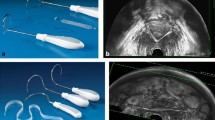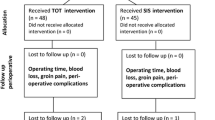Abstract
The aim of the study was to determine Monarc (American Medical Systems) sling position after surgical treatment of stress urinary incontinence (SUI) through the transobturator approach. A total of 54 consecutive women with SUI were evaluated post-operatively with transvaginal ultrasound. A concomitant hysterectomy was performed in ten cases and a concomitant prolapse surgery in six cases. Ultrasound measurements include urethral length, the distance between the upper edge of the sling and the bladder neck (BN–S) and the BN–S/U ratio. The mean distance between the transobturator tape and the bladder neck was found to be 12.6 ± 3.2 mm in the group of patients who underwent the transobturator procedure alone, 13 ± 3.1 mm in the transobturator plus hysterectomy group and 12 ± 2.8 mm in the transobturator plus prolapse group. The superior tape margin was at the mid-urethra in 81.5% of patients and always at a distance greater than 7 mm from the bladder neck. Eight patients did not have satisfactory results after the surgery. Only in one out of these eight patients was the transobturator sling not found to be at the mid-urethra. The superior tape margin of the Monarc sling remained at the level of mid-urethra in the majority of cases. It was never located too proximally beneath the bladder neck.


Similar content being viewed by others
References
Mellier G, Benyed B, Bretones S, Pasquier JC (2004) Suburethral tape via the obturator route: is the TOT a simplification of the TVT? Int Urogynecol J 15(4):227–232
Fischer A, Fink T, Zachmann S, Eickenbush U (2005) Comparison of retropubic and outside–in transobturator sling systems for the cure of female genuine stress urinary incontinence. Eur Urol 48:799–804
David-Montefiore E, Frobert JL, Grisard-Anaf M, Lienhart J, Bonnet K, Poncelet C, Daraï E (2006) Peri-operative complications and pain after the suburethral sling procedure for urinary stress incontinence: a French prospective randomised multicentre study comparing the retropubic and transobturator routes. Eur Urol 49(1):133–138
Krauth JS, Rasoamiaramanana H, Barletta H, Barrier PY, Grisard-Anaf M, Lienhart J, Mermet J, Vautherin R, Frobert JL (2005) Sub-urethral tape treatment of female urinary incontinence—morbidity assessment of the transobturator route and a new tape (I-STOP®): a multi-centre experiment involving 604 cases. Eur Urol 47:102–107
Zilbert AW, Farrell SA (2001) External iliac artery laceration during tension-free vaginal tape procedure. Int Urogynecol J 12:141–143
Delorme E (2001) Transobturator urethral suspension: mini-invasive procedure in the treatment of stress urinary incontinence in women. Prog Urol 11:1306–1313
De Leval J (2003) Novel surgical technique for the treatment of female stress urinary incontinence: transobturator vaginal tape inside–out. Eur Urol 44:724–730
Dietz HP, Mouritsen L, Ellis G, Wilson PT (2003) Does the tension-free vaginal tape stay where you put it? Am J Obstet Gynecol 188:950–953
Virtanen HS, Kiiholma P (2002) Urogynecologic ultrasound is a useful aid in the assessment of female stress urinary incontinence—a prospective study with TVT procedure. Int Urogynecol J Pelvic Floor Dysfunction 13:218–223
Tunn R, Petri E (2003) Introital and transvaginal ultrasound as the main tool in the assessment of urogenital and pelvic floor dysfunction: an imaging panel and practical approach. Ultrasound Obstet Gynecol 22:205–213
Davila GW, Johnson JD, Serels S (2005) Multicenter experience with the Monarc transobturator sling system to treat stress urinary incontinence. Int Urogynecol J Pelvic Floor Dysfunction 17:460–512
Ducarme G, Rey D, Ménard Y, Staerman F (2004) Echographie endovaginale et troubles mictionnels après TVT®. Gynecol Obstet Fertil 32:18–22
De Tayrac R, Deffieux X, Resten A, Doumerc S, Jouffroy C, Fernandez H (2005) A transvaginal ultrasound study comparing transobturator tape and tension-free vaginal tape after surgical treatment of female urinary incontinence. Int Urogynecol J Pelvic Floor Dysfunction 17:466–471
Dietz HP, Wilson PD (2004) The ‘iris effect’: how two-dimensional and three-dimensional ultrasound can help us understand anti-incontinence procedures. Ultrasound Obstet Gynecol 23:267–271
Lo TS, Horn S-G, Liang C-C, Lee S-J, Soong YK (2004) Ultrasound assessment of mid-urethra tape at three-year follow up after tension-free vaginal tape procedure. Urology 63:671–675
Viereck V, Nebel M, Bader W, Harms L, Lange R, Hilger R, Emons G (2006) Role of bladder neck mobility and urethral closure pressure in predicting outcome of tension-free vaginal tape (TVT) procedure. Ultrasound Obstet Gynecol 28:214–220
Poon C, Zimmern P (2004) When the sling is too proximal: a specific mechanism of persistent stress incontinence after pubovaginal sling placement. Urology 64:287–291
Dietz HP, Mouritsen L, Ellis G, Wilson PT (2004) How important is TVT location? Acta Obstet Gynecol Scand 83:904–908
Kaum HJ, Wolff F (2002) TVT: on midurethral tape positioning and its influence on continence. Int Urogynecol J Pelvic Floor Dysfunction 13:110–115
Mukherjee K, Constantine G (2001) Urinary stress incontinence in obese women: tension-free vaginal tape is the answer. BJU Int 88:881–883
Author information
Authors and Affiliations
Corresponding author
Rights and permissions
About this article
Cite this article
Foulot, H., Uzan, I., Chopin, N. et al. Monarc transobturator sling system for the treatment of female urinary stress incontinence: results of a post-operative transvaginal ultrasonography. Int Urogynecol J 18, 857–861 (2007). https://doi.org/10.1007/s00192-006-0244-1
Received:
Accepted:
Published:
Issue Date:
DOI: https://doi.org/10.1007/s00192-006-0244-1




